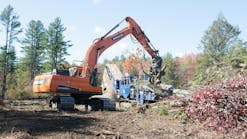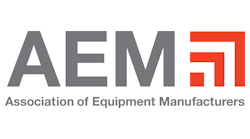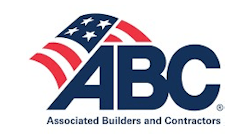As detailed in Joseph Lynn Tilton’s article, “Fleet Management II: Software and Systems for Equipment Tracking and Asset Management” (Grading & Excavation Contractor, March/April 2002), a variety of fleet management turnkey systems and software packages are being marketed to the construction industry. There seems to be general agreement that integrated fleet management systems have a great potential here, rivaling that now being realized by the trucking industry. However, the construction industry is far more decentralized, so it is only recently that an efficient sales and distribution system to outfit contractor fleets is evolving.A good case in point is MobileNet Inc. of Atlanta, GA, which offers a turnkey fleet management system called TrakPak designed specifically for the construction industry. Surprisingly, MobileNet’s Bill Purdie reports that the company’s primary sales targets are not end users but rather are (1) heavy-equipment manufacturers, (2) heavy-equipment dealers, and (3) rental fleets.Whereas the advantages for end-user contractors to implement fleet management systems have been well reported, the incentives for manufacturers, dealers, and rental fleets to aggressively distribute these systems are less obvious. Of course, there are value-added contributions delivered by these “attachments,” but these systems are relatively inexpensive as compared not only to the prices of the heavy equipment they would be attached to but also to the other attachments that manufacturers offer as options. Clearly the revenues generated by sales of such a system will have little impact on a heavy-equipment manufacturer’s profit picture.“But there are other less obvious but still important advantages to a manufacturer,” Purdie explains. “First, there is the issue of staying technologically competitive in the eyes of end users when they are making a buying decision. With the attractive advantages that fleet management systems offer to end users, manufacturers almost have to have such a system available or risk being downgraded in the buy analysis.“In addition, today’s systems can and do provide useful technical data feedback that can be used to enhance performance and/or reliability in future releases of heavy-equipment models. Since modern systems now have or soon will have to have a J-1708 interface, this hookup makes a wealth of vehicle information readily available, including engine hours, engine oil pressure, coolant temperature, transmission oil temperature, transmission control circuit malfunctions, and low brake pressure. The conditions and failure modes will be recorded and later used for failure analysis.“Also, if a manufacturer elects to do so, it can use the hard data the system provides to settle warranty disputes. For example, I have heard of one user who discovered that if he adjusted the hydraulic pump on his excavator, he could increase his work output; he was unconcerned about possibly overstressing the machine and causing it to break down since it was under warranty. However, TrakPak can detect overpressure in the hydraulic system, so if the contractor did make a claim under those circumstances, the manufacturer would have the hard data to establish that this was an out-of-warranty failure.”Manufacturers’ UsagePurdie reports that Kawasaki offers K-Link, a private brand version of the MobileNet system. Kawasaki’s Wayne Powell confirms that Kawasaki did indeed offer K-Link as an option on its construction vehicles, and he goes on to describe the system: “K-Link effectively provides a tie between the vehicles and a Web site that can be readily accessed by the owner’s responsible party. It provides location and hours daily, but it also ties into the machine’s warning system. If a problem occurs, an alert to this effect will go from the machine via satellite to the Web site where it can be accessed by the fleet manager.”According to Powell, the following faults are monitored: Low brake pressure (accumulator or differential pressure front- vs. rear-brake circuit)Low engine oil pressure (below about 7 psi – varies by machine model)High coolant temperature (more than 215°F)High transmission oil temperature (more than 250°F)Transmission control circuit malfunction (electrical problem)Loss of external power (dead or disconnected battery; battery voltage also is measured on some units)Moving outside of a GeoFence boundary (monitored even when the vehicle engine is shut off)The time it takes for a fault to be reported depends on the time to acquire a satellite. The K-Link system uses a Low Earth Orbit (LEO) satellite system for communication from the vehicle to the K-Link Central Asset Monitoring System, a Web site operated for Kawasaki by MobileNet. LEO service is provided by ORBCOMM Inc., a wireless telecommunications company providing narrow-band two-way digital messaging, data communications, and geopositioning services on a global basis. The company owns and operates a network consisting of 30 LEO satellites and terrestrial gateways deployed around the world. Small, low-power, and commercially proven subscriber communicators can connect to private and public networks, including the Internet, via these satellites and gateways.“LEO is particularly well suited to construction fleets that stay at job sites that may be out of cellular coverage or permanently obscured from the view of a geosynchronous satellite,” Powell notes. “Since the LEO has 30 satellites, it is highly probable that one of them will have line-of-sight contact with even the most obscured job site before long. If the machine works inside a large building, communications will be blocked. However, messages will be stored in the onboard TrakPak module until the machine leaves the building and a satellite can again relay the messages.“K-Link is not a real-time system. Once a day, five days a week, the TrakPak module reports the machine’s position and operating hours to a LEO satellite. If, at any time during the machine’s operation, a problem occurs, a red light in the cab appears. If, after a brief [preset] time, the fault indication still remains, either (1) an e-mail will be sent to the responsible party in the user’s organization, (2) a text message will be sent to that party’s cell phone, or (3) the system will page that party.“K-Link is offered as an option on Kawasaki vehicles, but a couple of our dealers have told us, ‘We want every machine we’re buying to have this option included.’ Orders for the K-Link option have been slow until this year, but now we’re getting more and more orders, principally from dealers for their own rental fleets. And yes, the system has already given us useful feedback. Recently we called a dealer to inquire about the disposition of an alert from one of the vehicles under a maintenance contract. He told us he had investigated the cause of that alert and found that a switch problem had caused the transmission not to operate. We use information like that in our program of continually improving the reliability of our vehicles.”Caterpillar has a system it calls Product Link that is functionally similar to K-Link. It consists of a global positioning system (GPS) receiver, a LEO communication module, an onboard processor, and a Web site integrated with the Caterpillar Dealer Storefront. According to Program Manager Chau Nguyen, “Product Link is available in two versions. PL151 provides updates on machine service hours, machine location, and Product Watch functionality. PL201 provides the same data plus machine health information captured from the standard Caterpillar bus [as opposed to a J-1708]. Product Watch is a feature that automatically sends e-mail or pager alerts when a machine operates beyond owner-chosen time and location limits.“Product Link was first released three years ago, and to date [October 1, 2002] 4,500 units have been sold,” Nguyen reports. “Market acceptance for these types of products is still in its infancy. Most customers have been acquiring units to evaluate the system. We are seeing a trend where fleet equipment managers are starting to outfit more of their fleets with Product Link. Increasing numbers of contractors are starting to ask for this type of technology for their operations.“We use the data fed back via Product Link to provide better predictive data on component life and failure modes so that we can improve the reliability of our machines. What’s more, when our design groups are developing a new machine, they are quite likely to put Product Link on a prototype machine to get feedback on machine performance during the development process. All in all, it has been a valuable design and analysis tool for us,” he concludes.Heavy-Equipment Dealer UsageHeavy-equipment dealers see even greater benefits and profit potential from fleet management systems. Clearly they will be right in the middle of the entire sales and service cycle. Ron Richardson, director of marketing for Hoss Equipment in Dallas, TX, sees this as an aftermarket business for some time to come. “Contractors will initially outfit their fleets’ existing equipment, and we dealers will be doing the in-field installation. These systems can easily be installed in two or three hours so there’s not any great economy in factory installation. Therefore, I think it will be some time, if ever, before factory installations exceed field installations.”Even so, the real plum for dealers seems to be the potential for bundling these systems with ongoing maintenance and service packages. Not only would a system sale increase the likelihood that a selling dealer would be awarded the after-sale maintenance contract, it almost surely would increase the dealer’s efficiency and lower the costs of performing preventative and other scheduled maintenance. Mark Tobyas of Ellen Equipment in Aurora, CO, told Tilton why: “‘By [having a dealer facilitate] a fleet management system, the contractor can focus on moving dirt while his dealer takes care of the machine. The arrangement helps him avoid downtime as well as build a service history that will give him a 2% to 5% advantage at trade-in. With a $50,000 machine, that 2% to 5% is quite a bit. Also, the customer has a product that the dealer wants to buy because the dealer knows the history of the machine.’ “Thanks to GPS,” Tilton adds, “dealer service techs know where to find the machine for a customized maintenance interval [CMI] without ever having to contact the customer. ‘For instance,’ relates Tobyas, ‘my service manager in Aurora had a unit at the base of a mountain 20 miles away on Interstate 70. The machine actually was over the hill from the rest of the machinery at that same site. It could have taken the service tech 30 to 45 minutes to find it once he got there, but with [Case Construction’s] FleetLink, he knew within five feet just where the machine actually was, so he kept driving until he got to it. Our techs will do five to 10 CMIs daily, and the time saved in locating equipment can be significant. It is so significant that Ellen Equipment puts the transponders on the equipment at no charge – providing the contractor signs a multiple-year service contract. We recognize we will recoup our expense within 24 months and give our contractors what they’re asking for. The software helps us improve our service level.'” Glenn Matteson, president of FleetEdge in Raleigh, NC, presents the case for the likelihood that dealers will increase their overall profits with fleet management systems, specifically his FleetEdge system. “By gaining approved access to FleetEdge information, dealers can turn customers into clients via surrogate fleet management. Working with its clients by monitoring the maintenance and utilization data available with the FleetEdge service, a dealer has the opportunity to enhance the critical after-sale relationship through control of maintenance contracts and increased parts and service business with its higher margins.”Richardson isn’t sure it will be that easy. “I think it will require a culture change first,” he comments. “Of course we would like to bundle fleet maintenance and take it over so that our maintenance staff performs all the PM [preventative maintenance] automatically without having to get specific customer approvals for every oil change. But there is a trust barrier to overcome before we can get into that enviable position. Contractors tend to be independent ‘show me’ people who wonder “How do I know all these maintenance tasks need to be done if I’m not supervising the operation?’ And another thing: Bundled services like these are only cost-effective for relatively local operations. If a contractor gets a job 50 to 100 miles away, it’s not going to be too practical for us to travel that distance for a simple oil change, however efficient our maintenance teams are. I think there is great potential in these systems, but I think the profit potential of bundled maintenance contracts is being overestimated.”Rental Fleet ProspectsHardly anyone has any doubts as to the potential for fleet management systems for rental companies (or dealer rental departments). As Matteson says, “A rental company can monitor its rental fleet daily to determine service interval schedules, to know the precise location of its fleet equipment, and to have documented evidence of the hours its equipment worked on a day-by-day basis. Not only does the system enable them to protect their investment in this expensive heavy equipment, it enables them to provide a needed service and increase their rental utilization for maximum rental margins. Indeed, rental houses have one of the strongest reasons to adopt this technology.”Miller-Bradford has eight dealerships selling, renting, and servicing new and used Terex construction equipment in the Midwest. Early in 2001, its Rockford, IL, dealership rented 15 40-ton articulated haul trucks from Terex America under a 12-month contract. The dealer then rerented them to a local contractor for work on a Union Pacific project that was estimated to take 12 months to complete. According to Joe Martin of Miller-Bradford, the contractor didn’t have the maintenance capability needed for this fleet, so he also contracted the maintenance to Miller-Bradford. To efficiently handle this contract, Miller-Bradford equipped the 15 trucks with FleetEdge systems, which it used to manage the maintenance and service.“This relieved the contractor of the maintenance headache,” Martin says, “and of course it added to our revenues. What’s more, we could be sure that our trucks were being properly maintained while they were on rental. We used it to track truck location, to monitor operating hours, to efficiently adhere to the proper PM schedule, and to alert us if such engine conditions as engine oil pressure and coolant temperature went out of spec. This enabled our mechanic on-site to check that truck and perform any required repair or maintenance before any serious breakdown could occur.“The project went very well, so well in fact that the contractor finished it four months ahead of schedule. That caused the system’s theft fence capability to become quite valuable. As the contractor diverted trucks to other projects, we were able to find out when they had been moved and where. Now we are involved in setting up a rental program with another contractor or contractors for these trucks when they come off rental. We’re taking back five of the 15 trucks each month and refurbishing them prior to renting them out again or returning them to Terex for its rental fleet. Since they were so well maintained, these trucks are more rentable [and resellable] than they would have been otherwise. And the contractor was so pleased that we expect to rent him more vehicles equipped with FleetEdge systems.”Idle vehicles represent a nightmare to fleet-renting companies, and contractors do not like to pay full rates when machines are not being used, as on rainy days or half days. FleetEdge has come up with a solution to this dilemma based on the capability of its fleet management system. It charges the rental company a two-tiered fee. This fee consists of (1) a low daily charge that covers FleetEdge’s hardware and software costs and (2) an hourly usage charge (covering communications airtime) for just those hours the machine actually is being used. Those usage data, of course, are generated automatically by FleetEdge’s system so both parties have the same data. The rental company can then pass a similar deal on to the renting contractor.MobileNet offers a similar arrangement, and Purdie says it has enabled rental companies to extend the concept to rental of the vehicles themselves and place “spare” machines on a contractor’s job site for his use when job needs fluctuate. Again, the contractor only pays a basic amount when the equipment is not being used, thereby providing him with low-cost convenience and insurance against job interruption in case there is a breakdown or job spike at a remote job site.It would appear that accommodations such as these are being worked out as this fledgling industry begins to mature. And there are almost certainly additional possibilities that haven’t yet been explored. For example, Kawasaki’s Powell speculates that if a renter of heavy equipment at a remote job site doesn’t pay his rental bill, the system could be so programmed that the renter would be unable to start the equipment the next day. When the contractor’s payments are again current, the system could send another command reenabling the vehicle(s). The entire process would be completed without traveling to the job site.Similarly, a dealer in Arizona had fueling as well as full-service maintenance contracts supporting widely dispersed job sites in the state. To reduce unnecessary traveling costs, he had his system programmed to measure fuel level and send an alert if the level drops below a quarter tank. With this alert, the dealer won’t have to take unnecessary fueling trips to job sites and the contractors won’t have vehicles out of gas.Richardson envisions that contractors might set fleet standards, such as engine revving maximums, idle-time limits, and other operational factors, that will extend equipment life, lower repair costs, and/or enhance performance of their expensive heavy-construction vehicles. And he confidently expects fleet management system suppliers to adapt their alert systems accordingly. “There are some great bottom-line impacts that will be forthcoming as fleets learn to use these systems for maximum benefit,” he concludes, “and with responsive suppliers, I see all the potential in the world for these systems.”








